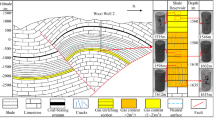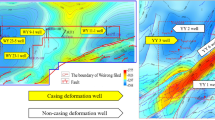Abstract
The casing deformation issues have occurred widely in Changning-Weiyuan National Shale Gas Demonstration Area. During multi-stage volume fracturing process, a large amount of fracturing fluid is injected into the formation, leading to tremendous change of stratum property and formation stress field. To assess the influence of shale formation on casing deformation, the acoustic velocity is measured to obtain the shale rock elastic modulus after saturation with water for different times. Then, the three-dimensional physical and finite element models are established using the stage finite element method considering transient thermal-pressure coupling. Shale anisotropy, shale stiffness degradation, and formation slip are taken into account to investigate the influences on casing deformation. Experiment results indicate that shale stiffness degrades dramatically after saturation with water for 24 h. Numerical simulations indicate that the shale modulus degradation mainly leads to large casing stress. Formation slipping not only causes excessive casing stress, but also causes large casing displacement. When slipping distance is larger than 15 mm, casing stress can reach up to the yield stress for P110 grade casing. Meanwhile, the casing deformation will be 14.95 mm, blocking the fracturing tools into the well bottom. Shale anisotropy has a minor influence on casing deformation.









Similar content being viewed by others
References
Davies RJ, Almond S, Ward RS, Jackson RB, Adams C, Worrall F, Herringshaw LG, Gluyas JG, Whitehead MA (2014) Oil and gas wells and their integrity: implications for shale and unconventional resource exploitation. Mar Pet Geol 56(9):239–254
Gao Q, Tao JL, Hu JY, Yu XB (2015) Laboratory study on the mechanical behaviours of an anisotropic shale rock. J Rock Mech Geotech Eng 7(2):213–219
Gao C, Xie LZ, Xie HP, He B, Jin WC, Li F, Yang ZP, Sun YZ (2017) Estimation of the equivalent elastic modulus in shale formation: theoretical model and experiment. J Pet Sci Eng 151:468–479
Gray KE, Podnos E, Becker E (2009) Finite-element studies of near-wellbore region during cementing operations: part I. SPE Drill Complet 24(1):127–136
Guo XL, Li J, Liu GH, Xi Y, Zeng YJ, He M, Yan H (2018) Numerical simulation of casing deformation during volume fracturing of horizontal shale gas wells. J Pet Sci Eng 172:731–742. https://doi.org/10.1016/j.petrol.2018.08.067
Jo H, Gray KE (2010) Mechanical behavior of concentric casing, cement, and formation using analytical and numerical methods. In: the 44th US Rock Mechanics Symposium and 5th U.S.-Canada Rock Mechanics Symposium. American Rock Mechanics Association, Salt Lake City, UT
Kan M, Ipek O, Gurel B (2015) Plate heat exchangers as a compact design and optimization of different channel angles. Acta Phys Pol A 128(2-B):B49–B52
Koru M, Serçe O (2015) Experimental and numerical determination of casting-mold interfacial heat transfer coefficient in the high pressure die casting of A-360 aluminum alloy. Acta Phys Pol A 130(1):453–458
Lin TJ, Yu H, Lian ZH, Yi ZH, Zhang Q (2016) Numerical simulation of the influence of stimulated reservoir volume on in-situ stress field. J Nat Gas Sci Eng 36:1228–1238
Liu W, Yu BH, Deng JG (2017) Analytical method for evaluating stress field in casing-cement-formation system of oil/gas wells. Appl Math Mech 38(9):1273–1294
Lü ZQ, Yang X, Wei JX (2015) Non-contact measurement of the anisotropy in shale with all-optical detection (in Chinese). Sci Sin-Phys Mech Astron 45(8):63–70
Rocha-Valadez T, Mentzer RA, Hasan AR, Mannan MS (2014) Inherently safer sustained casing pressure testing for well integrity evaluation. J Loss Prev Process Ind 29:209–215
Sugden C, Johnson J, Chambers M, Ring G, Suryanarayana PV (2012) Special considerations in the design optimization of high rate, multistage fractured shale Wells. In: IADC/SPE Drilling Conference and Exhibition. Society of Petroleum Engineers, San Diego, California, USA
Vachaparampil A, Hu LB, Zhou XJ, Ahmad G, Gill I, Chitrala Y (2016) Geomechanical anisotropy of utica shale from static and dynamic measurements. In: the 50th U.S. Rock Mechanics/Geomechanics Symposium. American Rock Mechanics Association, Houston, Texas, USA
Yan W, Zou LZ, Li H, Deng JG, Ge HK, Wang HG (2017) Investigation of casing deformation during hydraulic fracturing in high geo-stress shale gas play. J Pet Sci Eng 150:22–29
Zhang WC, Eckert A, Liu X (2017) Numerical simulation of micro-annuli generation by thermal cycling. In: The 51st U.S. Rock Mechanics/Geomechanics Symposium. American Rock Mechanics Association, San Francisco, California, USA
Zhou C, Wu XD, Li H, Ren ZX, Xin YN (2015) Influence of in-situ stress distribution on selection of fracturing fluid backflow technology. Acta Phys Pol A 130(1):347–351
Funding
This work was supported by National Natural Science Foundation of China, Project No. U1762211 and 51674272, National Science and Technology Department of China, Project No. 2017ZX05009-003, and Petroleum Engineering Technology Research Institute Development Fund of China Petroleum & Chemical Corporation, Project No. HX20180001.
Author information
Authors and Affiliations
Corresponding authors
Additional information
This article is part of the Topical Collection on Geo-Resources-Earth-Environmental Sciences
Rights and permissions
About this article
Cite this article
Guo, X., Li, J., Liu, G. et al. Shale experiment and numerical investigation of casing deformation during volume fracturing. Arab J Geosci 11, 723 (2018). https://doi.org/10.1007/s12517-018-4091-4
Received:
Accepted:
Published:
DOI: https://doi.org/10.1007/s12517-018-4091-4




